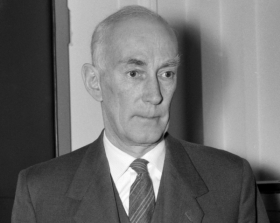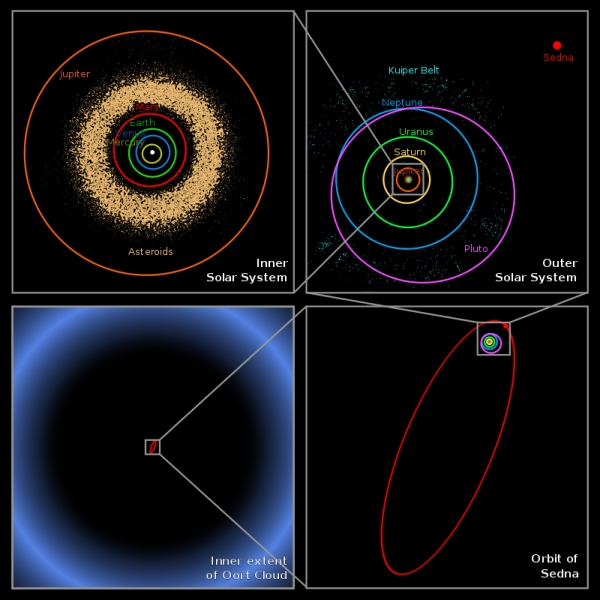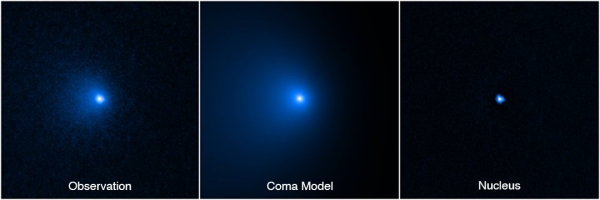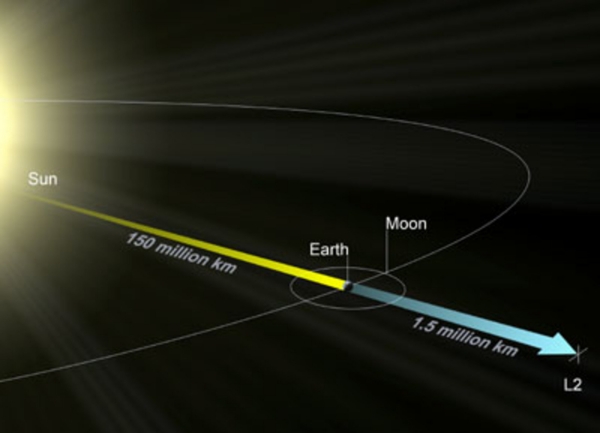
It pleases me to learn that Dutch astronomer Jan Oort was among the select group of people who have seen Halley’s Comet twice. At the age of 10, he saw it with his father on the shore at Noordwijk, Netherlands. In 1986, he saw it again from an aircraft. What a fine experience that would have been for a man who brought so much to the study of comets, including the idea that the Solar System is surrounded by a massive cloud of such objects in orbits far beyond those of the outer planets.
Image: Dutch astronomer Jan Oort, a pioneer in the study of radio astronomy and a major figure in mid-20th Century science. Credit: Wikimedia Commons CC BY-SA 3.0.
Halley’s Comet is a short-period object, roughly defined as a comet with an orbit of 200 years or less, and thus not a member of the Oort Cloud. But let’s linger on it for just a moment. The most famous person associated with two appearances of Halley’s Comet is Mark Twain, who was born in 1835 with the comet in the sky, and who sensed that its approach in 1910 would also mark his demise. As Twain put it:
I came in with Halley’s Comet… It is coming again … and I expect to go out with it… The Almighty has said, no doubt: ‘Now here are these two unaccountable freaks; they came in together, they must go out together.’
And so they did.
Edging in from the Oort
The Oort Cloud is an intriguing concept because by some accounts, it may extend halfway to the nearest star, meaning that it’s conceivable that the cometary cloud around the Sun nudges into a similar cloud around Centauri A/B, assuming there is one there. We use the Oort to explain the appearance of long-period comets, assuming that among these trillions of objects, a few are occasionally nudged out of their orbits and fall toward the Sun. The concept makes sense but observational data is sparse, as these dark objects are not directly observable until one of them moves inward.

Image: The presumed distance of the Oort cloud compared to the rest of the Solar System. Credit: NASA / JPL-Caltech / R. Hurt.
We’ve recently learned about a long-period comet with interesting properties indeed. C/2014 UN271 (Bernardinelli-Bernstein) is the object in question, named after the two astronomers who discovered it in Dark Energy Survey (DES) data at a heliocentric distance of 29 au. Recent work with the Hubble Space Telescope has determined that the object may be as much as 130 kilometers across, making it the largest nucleus ever seen in a comet. Moreover, we can assume that it’s not an aberration.
David Jewitt (UCLA) is a co-author of the paper on this work:
This comet is the tip of the iceberg for many thousands of comets that are too faint to see in the more distant parts of the solar system. We’ve always suspected this comet had to be big because it is so bright at such a large distance. Now we confirm it is.”
Getting an accurate read on an object like this was no easy matter. At this distance from the Sun, the nucleus is too faint to be resolved even by the Hubble instrument, so Jewitt and team had to rely on data showing the spike of light where the nucleus was thought to be. Lead author Man-To Hui (Macau University of Science and Technology) led the development of a computer model of the surrounding coma, adjusting it to the Hubble data and then subtracting its glow, leaving behind the nucleus. Observations from the Atacama Large Millimeter/submillimeter Array (ALMA) confirmed its size and also made it clear that the nucleus is, as Jewitt puts it, “blacker than coal.”

Image: Sequence showing how the nucleus of Comet C/2014 UN271 (Bernardinelli-Bernstein) was isolated from a vast shell of dust and gas surrounding the solid icy nucleus. Credit: NASA, ESA, Man-To Hui (Macau University of Science and Technology), David Jewitt (UCLA). Image processing: Alyssa Pagan (STScI).
Intercepting a Comet
If long period comets are difficult objects to study from Earth orbit, we may need to get up close with a spacecraft. It’s good to hear that the European Space Agency has approved the mission known as Comet Interceptor for construction, slotting it to fly in 2029 in the same launch that will carry the Ariel exoplanet finder into space. We’ve studied comets before, of course, including Halley’s, with notable success. But it’s obvious that short-period comets like the former and Rosetta target 67/P Churyumov-Gerasimenko would have been changed by their long proximity to the inner Solar System. What will we find when we study a newly arriving Oort object?
Michael Küppers is an ESA scientist working on the Comet Interceptor mission:
“A comet on its first orbit around the Sun would contain unprocessed material from the dawn of the Solar System. Studying such an object and sampling this material will help us understand not only more about comets, but also how the Solar System formed and evolved over time.”
Both Ariel and Comet Interceptor will proceed to the L2 Lagrangian point 1.5 million kilometers from the Earth, where the latter will wait for a target, presumably an Oort object jostled inward by gravitational interactions. Here we rely on the fact that comets are often detected more than a year before they reach perihelion, a time too short to allow for the construction of a dedicated space mission. The plan is to make Comet Interceptor ready to move when the time comes, performing a flyby of the incoming object and releasing twin probes to build up a 3D profile of the comet.

Image: An illustration of the L2 point showing the distance between the L2 and the Sun, compared to the distance between Earth and the Sun. Credit: ESA.
ESA will build the spacecraft and one of the two probes, the other being developed by the Japanese space agency JAXA. Given that over 100 comets are known to come close to Earth in their orbit around the Sun, along with the 29,000 asteroids cataloged so far, it will likewise be useful to have a better understanding of the composition of a pristine comet in case it ever becomes necessary to take action to avert an impact on Earth.
And if the target turns out to be an interstellar new arrival like ‘Oumuamua? So much the better. We should be finding more such newcomers shortly, given the success of the Pan-STARRS observatory and the development of the Large Synoptic Survey Telescope, now known as the Vera C. Rubin Observatory, under construction in Chile. Waiting in space for an Oort object or an interstellar comet means we won’t need to know the target in advance, but can adjust the mission as data become available. In any case, ESA is optimistic, saying Comet Interceptor “is expected to complete its mission within six years of launch.”
An ESA factsheet on Comet Interceptor can be found here. The paper on C/2014 UN271 (Bernardinelli-Bernstein) is Man-To Hui et al, “Hubble Space Telescope Detection of the Nucleus of Comet C/2014 UN271 (Bernardinelli-Bernstein),” Astrophysical Journal Letters Vol. 929, No. 1 (12 April 2022) L12 (abstract).



Most of the Oort Cloud is outside the Sun’s Heliosphere and would receive many more encounters with dust and gas as we travel around the galaxy. Some of the interstellar clouds are very dense and may add large quantities of mass to the Oort cloud members. If these objects are blacker then coal it would be hard to detect them even if they are a large as a low density Mars. These objects may be better then rogue planets for transferring between solar system, they have all the ingredient’s to keep organic life alive. Far out from the Sun’s gravity well and with the necessary elements for fusion heating and drives. Maybe we need to look for some transient hot signal from Oort cities closer to the sun. They may even have canals! ;-}
What do we expect to be different between an Oort Cloud object and a Kuiper belt object that makes it worth chasing a new comet from the Oort Cloud?
Hi Alex
Well until we have a close up look, we don’t yet know. Our cosmogony is limited for data since we’ve never looked at a “pristine” OCO up close.
Let me rephrase my question. What hypothesis would we be testing about the formation of Oort objects vs KBOs, and their subsequent history?
We can always just look and see what we can find, but when the funding will come at the cost of other projects, there needs to be some science payoff to support the experiment.
“Both Ariel and Comet Interceptor will proceed to the L2 Lagrangian point 1.5 million kilometers from the Earth, …”
Are we gonna fill up the L2 Lagrangian point pt. like we filled up NEO ?
While L2 is technically an unstable gravitational position, in practice spacecraft are put in halo orbits around those points. This provides a lot of room to park those spacecraft. It will be a very long time before such Lagrange points are “filled up”.
Halo orbit:
The L2 volume is huge !
L2 is a circle, basically, not a volume
That is not correct. See the reference 3 from the Wikipedia article on Halo Orbits:
Three-Dimensional Periodic Halo Orbits
charlie makes a valid point. JWST is already in STL2. How many orbits can fit in this halo?
exactly !
I am surprised by the prediction of six years, was expecting longer. L2 must make a lot of orbits accessible.
There are so many interesting objects to ambush! As well as interstellar wanders, some of the Oort cloud may be composed of material from the Sun’s stellar nursery or, was captured from other systems along the Sun’s journey. Oort cloud objects are composed mostly of water and methane. It is possible they will be the first commercially viable object to capture and mine.
The “ambush from L2 or Lx” mission type is interesting. With so many possible targets, it could become a research archetype that could span generations of scientists.
Do we have any idea how common Oort style clouds might be around other stars? The point you raise about it extending half way to Alpha Centauri is interesting: we know other stars have come much closer to the Sun in the past. How might the Oort clouds of two stars interact in such an encounter?
Speculation based on the expectation of Oort cloud objects snagged from other stellar systems in the solar system’s galactic wanderings may allow the possibility, albeit remote, of finding biological or technological artifacts of unknown provenance, leading to rife but unsubstantiated and insoluble further speculation; and as an answer to Fermi’s paradox, the riddle may grow deeper.
Random small bodies in space are about to get a big bump in interest. Have a look at what ALMA just came up with for Psyche! https://agupubs.onlinelibrary.wiley.com/doi/10.1029/2021JE007091 They’re talking about areas of the surface that may be 40% metal based on dielectric constant, with tremendous variety of topography suggesting it really is the core of a dead planetoid, complete with bits of deep mantle to study. And there’s a probe on the way! Mountains of gold can’t be guaranteed … but can you rule them out?
Fresh Oort cloud objects are a different kind of wealth, still valuable. Picture five Earth masses of air and water stretching to the stars, waiting to be turned into a civilization.
There is a tradeoff here. Oort objects are very far off, and very sparsely distributed. KBOs are closer and easier to reach, with basically the same composition. Arguably dead comets are even easier to reach. I have argued before that Ceres alone is a great resource just within the inner system.
Because the Oort objects have a very low orbital velocity and their distance apart is so large, any colony wanting to slowly migrate outwards would have to accelerate and decelerate to each object, a huge waste of energy and mass. I have to wonder at the sense of taking this approach.
You’re right in the short term: if you can colonize Pluto, why go to the Oort cloud? Similarly Callisto, Ceres, Ryugu, Antarctica. But if people diffuse outward, eventually Oort should be on the menu.
But I think energy requirements for transportation should be very low. Oort cloud colonization has advantages: vacuum, empty space, and time. Vacuum means that stopping and starting can be highly regenerative (even more than braking an electric car). The empty space provides the option to have long “runways” to accelerate and decelerate. And the time implies that each jump between Oort cloud objects can be handled like a long-awaited Mars colonization mission – careful study of the trajectory, landing of small probes, robotic assembly of support infrastructure.
For example, suppose two Oort cloud objects have a close approach in a century. First you land a corner reflector on the virgin surface and measure light paths to your home object down to the micrometer. The reflector and your next probe use some of those 99.9999% reflective mirrors I hear about with Starshot, so the next probe can bounce light back and forth a million times and get a million times its laser’s light pressure to slow down at the destination. When it returns it can speed up the same way. (A “space fountain” approach with physical masses also works, but matter is slower and seems more prone to mishap) Later on you have objects positioned at intervals along the approach path to push against – closer and less nervewracking targets for your laser beam, which settle momentum among themselves later by the same means.
In the long run the entire Oort cloud could be connected and its motions planned out carefully, with every body pressing against the other with the sheer weight of commerce and communications. Residents could migrate from body to body at close approaches, with a plan of transfers that uses the relative motion of the objects to best advantage. But faster ships can also be part of such a network, especially if momentum is being sent outward on all sides for interstellar colonization projects.
“… , performing a flyby of the incoming object and releasing twin probes … ”
Why not just match speed an move along with the incoming object ?
Hi charlie
That’s a LOT harder to do. Propulsion can only do so much.
To expand on this, your probe needs to use more propellant to both decelerate to match the comet’s speed AND alter its trajectory to match the comet’s orbit, e.g. its inclination to the ecliptic. This propellant adds mass and reduces the acceleration of the probe making the rendezvous harder and adding costs.
“To expand on this, your probe needs to use more propellant to both decelerate to match the comet’s speed AND alter its trajectory to match the comet’s orbit, e.g. its inclination to the ecliptic.”
Uh, … jupiter gravity assist ?
If the comet is outbound, the probe must have a velocity greater than the comet to catch up. and then decelerate to match velocity, and that is before any inclination adjustments. For an inbound comet, the probe must achieve an interception orbit and then go through similar velocity changes.
A Jupiter gravity assist for both velocity and inclination changes is fine if the comet is obliging in approaching on a trajectory where this could be useful. Not so much when Jupiter is not in a useful position to help the probe.
IIRC, didn’t Andreas Hein do some extensive work to find the most economical trajectories for comets like ‘Oumuamua and Borisov? This would be relevant for long period Oort cloud comets.
Yes, I think Andreas and team’s work is relevant. I’ve been talking to him about posting an article here summarizing the latest from this investigation.
Could the Oort/heliopause interfere with SETI…like radar’s ground clutter? The FAST dish pick up something?
I wonder if a future civilization could reach other stars by slowly (over thousand of years) populating the Oort cloud of our system and from there to a neighbour’s star cloud. Kind of like the Polinesians jumped from island to island in the Pacific.
Back in the late 70s, it was either in essays or the book “The Starship and the Canoe” where Freeman Dyson speculated on future humanity’s nomadic wandering across the Oort Cloud, til finally it entered off into the next stellar domain available. Not sure of the timeline, but it might mean it could be a different star system made available than Alpha Centauri, considering the time scales.
On the other hand, I would like to point to sample analyses conducted by the Japanese Space Agency (JAXA) returned from Ryugu via the Hayabusa2 spacecraft, ejecting a re-entry capsule recovered in western Australia’s desert about a year ago. Many investigators and several reports, which highlight two concepts. Ryugu, the charcoal briquette shaped NEO with a diameter of a kilometer or so, turned out to be of the carbonaceous chondrite variety. Assaying its mineral content beyond hydrogen and helium, their abundances were noted to be close to the solar. Formation was at a temperature much lower than that prevailing in its vicinity now. Less than 100 K. Maybe 60. So these were the general planetary science features.
As for astrobiology, there were numerous amino acids.
https://global.jaxa.jp/press/2022/06/20220610-1_e.html
Since Ryugu’s chemistry suggests that it both originated much further out in the solar system – or else in a cooler region with respect to a very
early evolutionary stage of the sun – it is possible that much of the leg work for life on Earth was performed far away from its surface – at a time when on Earth it was blistering hot. Considering that our estimate’s of Oort’s Cloud are extensive as they are, and that about many, if not a majority, Oort Clouds might exist as well, it would appear that the chances for life are increased ( e.g., as factors in the Drake equation). Example: whether it was 5 or 10 billion years ago that a local cloud reached a threshold with amino acids, viral organisms or whatever, the odds of propagation or galactic distribution would be increased over that within a particular environment such as early Earth or Mars as an origination. Less “unique” (sic) with such a supposition.
I suspect that the JAXA team’s pioneering work will come to be appreciated more and more if that line of reasoning heads toward any other discoveries. Had New Horizons after Pluto been able to examine
Ultima Thule/ Arrokoth in greater detail, we no doubt would have found a less distilled version of Ryugu, having remained at the Solar System’s edge. And one might wonder how far into this region you have to go to look for formations with still solar abundances of elements but formation dates earlier than that of the sun. If they are there, then biochemistry might precede solar formation.
The Starship and the Canoe” by Brower, Kenneth
To live in the Oort cloud, we would need to master self-sustaining habitats that get as close to closed systems as possible. Once we master these vehicles/homes, we don’t really need to island hop through the Oort cloud. The inner system has more resource dense staging areas for these habitats as well. The Oort cloud objects could be transformed into power beaming facilities to service interstellar vehicles.
I believe it is ESA protocol that their expeditions are moved out of the region as part of the decomissiong process at the end of mission life. They are sent into a heliocentric ‘graveyard orbit’.
Is it feasible to think of power beaming facilities as a backbone infrastructure for future spaceflight, essentially regardless of the magnitude of the distance involved? It looks to me as if one essential property regarding a ‘very deep space facility’ is its mass? Not too big, or it will have a too large gravity of its own, and access becomes difficult, and not too small, approaching that of the vessel to be accelerated?
Power beams are attractive, but economics will determine location. Now they must be on the Earth’s surface as the cost to put them in space is prohibitive. Even on Earth, they are very expensive.
If we could set up manufacturing of the power supply and lasers on the Moon, that would be a nice, stable, base to locate the beamers. Whether this is economic will depend on the cost to place material extraction, refining, and component manufacturing plant on the Moon. I think this is a long way off to be viable, although I could see small demonstration facilities placed on the Moon as pilot projects.
We need to gain the experience of building and using beamers on Earth before we can seriously think of space-based systems.
In Heinlein’s “The Moon is a Harsh Mistress”, the lunar revolt ended by chucking large rocks onto Earth as dumb kinetic missiles. Imagine updating this with very powerful lasers built on the Moon, perhaps on the farside, with orbital mirrors to direct the beams to targets on Earth.
Oort cloud comets may spin themselves to death
How icy objects from the solar system’s fringe disintegrate is a long-standing mystery
https://www.sciencenews.org/article/oort-cloud-comets-spin-death
Comet 67P has the building blocks of life — smells like mothballs and almonds
By Robert Lea published 1 day ago
Comet 67P/Churyumov-Gerasimenko is rich in organic molecules that play a key role in the development of carbon-based life.
https://www.space.com/comet-67p-ingredients-for-life-smells?utm_campaign=58E4DE65-C57F-4CD3-9A5A-609994E2C5A9